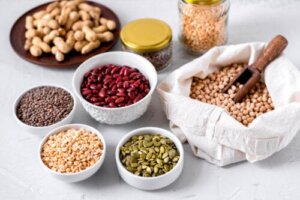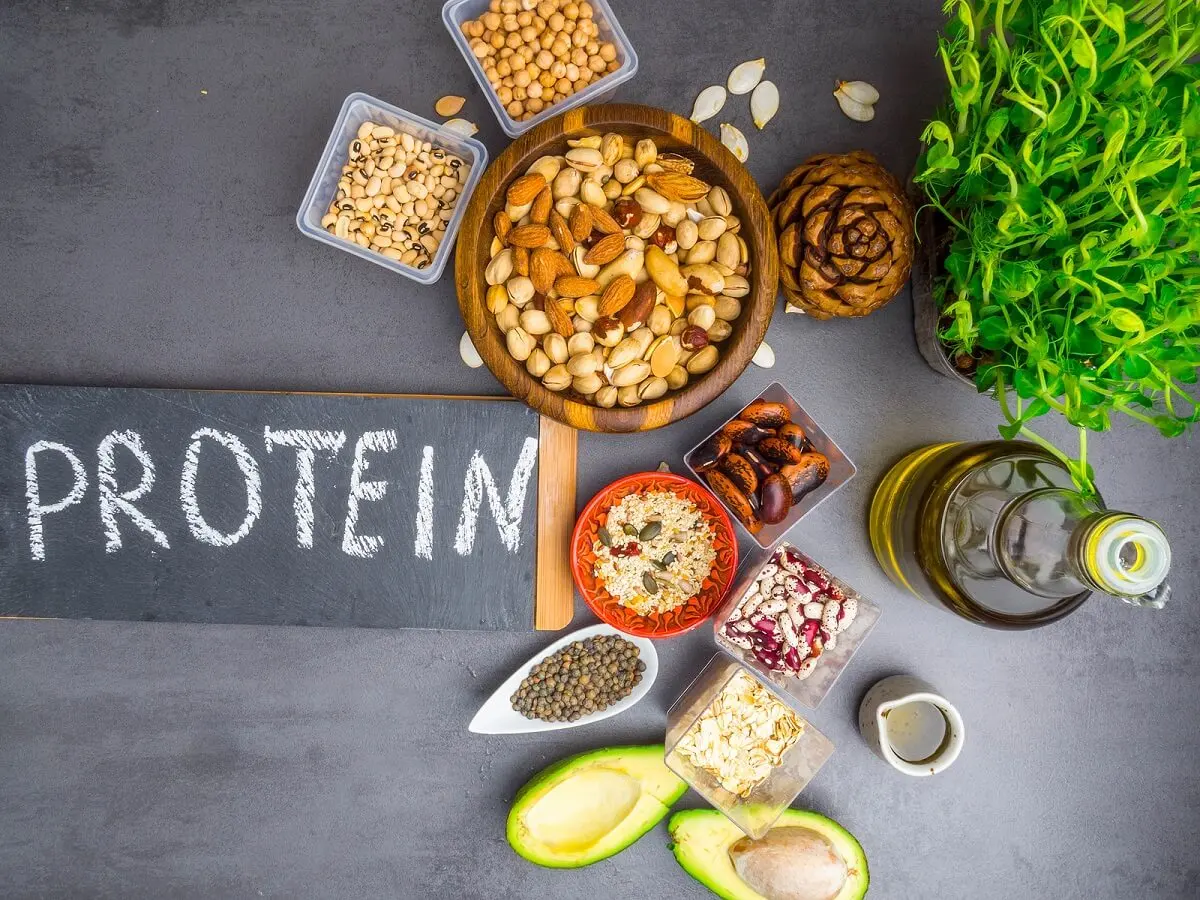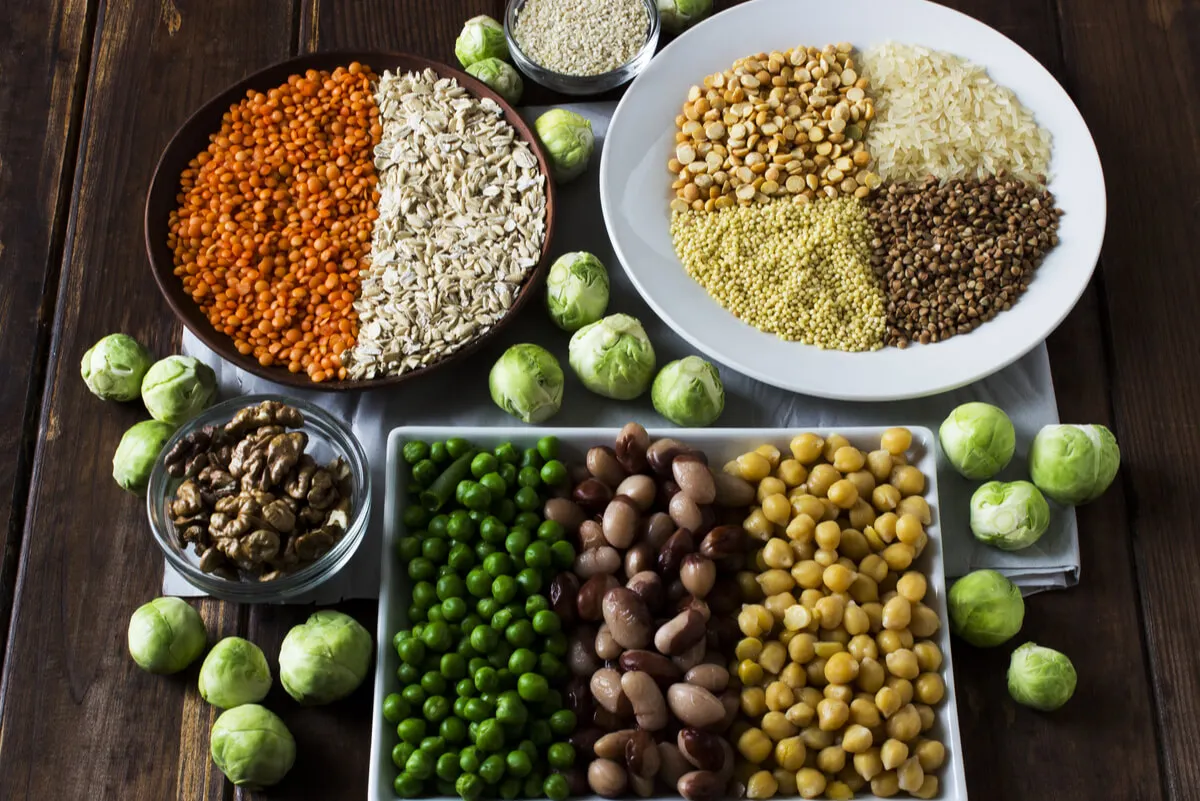Is Vegetable Protein Fattening?


Written and verified by the nutritionist Maria Patricia Pinero Corredor
Some people believe that vegetable protein is better than animal protein. However, when you consume it in excess it’s just as fattening. For many followers of different diets, this macronutrient represents the best part of the diet plan. After all, they’re associated with the formation of cells, molecules, and tissues, as well as giving you the feeling of satiety. So, is vegetable protein fattening?
However, what many people aren’t aware of is that the caloric content of vegetable protein is the same as that of animal protein and carbohydrates in our diets. Even so, as a nutrient, its main aim isn’t to provide energy or to be stored to gain weight. It has quite different functions. So, is it advisable to consume it? Here we’ll take a look at this issue in detail.
What are proteins and how do they work?
Proteins in food are the only macronutrients that provide nitrogen for the body. They’re made up of amino acids, which are joined together to form larger molecules. In total, there are 20 amino acids; 9 are considered essential though, and must be supplied through food.
The reason for this is that the body doesn’t manufacture them by itself. Non-essential amino acids, on the other hand, are produced in the body. If the protein contains all 20 amino acids, it’s considered “complete”. It’s used to form tissues, antibodies, enzymes, hormones, among other functions.
However, there are very few complete proteins and, for this reason, they must be combined with each other. In this regard, it’s important to realize that those of vegetable origin have fewer amino acids than those of animal origin.
In spite of this, it’s possible to achieve a complete protein when different vegetable foods are combined, such as legumes with cereals, for example.
In summary, the main function of proteins isn’t to provide energy to the body; that’s what carbohydrates and fats are for. Only when there’s a deficit in energy intake are they used as an emerging caloric source.
Moreover, it isn’t only their quality that’s important in a diet. The quantity consumed is fundamental to cover each person’s requirements.

Read more: Hypervitaminosis: The Excess of Vitamins
How much protein does a person need?
Some experts consider the official recommended protein intake to be somewhat low if muscle mass and good health are to be maintained. Specifically, government entities suggest o.8 grams per kilogram of body weight. But that wouldn’t be enough.
In other words, a 68-kilogram adult would need about 54 grams (2 oz) of protein per day, according to these criteria. Older adults require a little more to avoid age-related loss of muscle mass. The value is 1.3 grams per kilogram of weight.
So far, we know that a diet rich in protein whose objective is to lose weight should provide between 1.2 and 1.6 grams per kilogram of weight. These values represent between 20 and 30% of the daily calories that would be provided by protein.
On the other hand, the journal The American Journal of Clinical Nutrition disclosed that for the body to use this macronutrient better, its intake should be distributed evenly throughout the day and not in a single meal.
Is vegetable protein fattening?
Vegetable protein isn’t fattening. In fact, animal protein isn’t fattening either. In a balanced and sufficient diet, adapted to the calories required in the diet plan, each nutrient must fulfill its function.
For example, carbohydrates are the main source of energy for activity and daily metabolism. Fats also provide energy and form necessary compounds in the body. They’re stored and used as a caloric source when carbohydrates are depleted. Proteins have a restorative function.
If you eat more than necessary, not only of proteins, but also carbohydrates and fats, weight gain will occur. But this must occur under excessive caloric intake conditions.
For this reason, it’s important to balance the consumption of each nutrient in the diet and to be clear about the objectives that each one pursues in your diet plan.
Some vegan proteins that are marketed in powder form can favor the development of lean muscle, but not of body fat. This occurs when ingested in conjunction with strength training to help tone muscles.
If so, weight gain from increased muscle fiber isn’t interpreted as excess weight. On the contrary, when high amounts of vegan or animal proteins are included in a diet, it’s possible to lose weight. How? Let’s look at their properties.
Properties of proteins that help weight loss
It’s clear that vegetable protein isn’t fattening. On the contrary, some research indicates that increasing the intake of this macronutrient can have positive effects on weight loss.
- Proteins take longer to digest. Hence, their satiety power is greater than that of carbohydrates. In addition, they reduce ghrelin or hunger hormone levels, while increasing the hormones that give the sensation of fullness. Therefore, when eating a calorie-restricted diet, they helps to lessen the hunger that occurs.
- As protein assimilation is slower, the metabolism remains active for longer and thus more calories are burned during its digestion. The metabolic rate of protein digestion increases by 20 to 35% compared to an increase of 5 to 15% for fats and carbohydrates. By ingesting them and having a physical exercise plan, the weight loss effect increases.
- High protein intake for weight loss protects against loss of muscle mass. In the face of caloric restriction, the body uses lean tissue as an energy source. On the other hand, a high protein intake will help to form muscle fiber.
Main sources of vegetable protein
Not all vegetables provide vegetable protein. Their main sources are seeds and grains, as well as their derivatives. Let’s have a look at this in detail.
- Legumes: These are considered to be one of the most concentrated sources of protein. For example, one cooked cup of lentils provides about 18 grams of protein. Beans of different colors and chickpeas also enrich the diet with vegetable protein. They provide 15 grams for each cooked cup.
- Seitan: This is a gluten-based protein food. It’s known as “wheat meat”. About 100 grams (4 oz) provide 25 grams of protein. It can be sautéed, grilled, or fried to add to many recipes.
- Tofu, tempeh, and edamame: These 3 products are made from soybeans. Tofu is a kind of cheese whose neutral flavor adapts to any recipe. Tempeh is obtained by cooking mature soybeans, fermenting them, and then pressing them. Edamame are unripe seeds. The protein of these products ranges from 12 to 20 grams per 100 grams (4 oz) of serving.
- Nutritional yeast is an inactive strain of yeast used to make bread and alcoholic beverages. Because of its cheesy flavor, it’s used to enhance the flavor of other preparations. Half an ounce provides 8 grams of protein.
More sources of vegetable protein
- Spirulina: This is algae which is highly concentrated in protein and, therefore, only 2 tablespoons provide 8 grams. It also contains iron and copper, in addition to other minerals and vitamins.
- Amaranth and quinoa: These are considered pseudocereals because they don’t grow from grasses. However, they can be ground and prepared like cereal flours. One cup of them cooked provides 8 to 9 grams of protein.
- Soy milk: This is a substitute for cow’s milk. One cup provides 6 grams of protein. Ideally, it should be fortified, as it lacks vitamin B12.
- Chia seeds: These are a source of the best vegetable protein. One ounce gives 5 grams of protein and 10 grams of fiber. In addition, the magazine Molecules highlights the variety of beneficial healthy compounds it has.
- Nuts: These are excellent sources of protein. One ounce contains 5 to 7 grams, depending on the variety. Although it’s true that they’re high in fat, these are healthy fats, as explained in Nutrients magazine. They maintain their nutrients better when raw and not roasted.

Discover more here: 7 Protein Snacks to Increase Muscle Mass
Should I eat more vegetable protein?
Vegetable proteins in the diet play the same role as those of animal origin. After all, they’re nitrogenous substances that perform synthesis and repair molecules and tissues. Their caloric distribution as part of the daily intake doesn’t necessarily produce weight gain.
However, if you’re interested in including more protein in your diet, you should consult a nutritionist to define the objective of your plan and which nutrients you should compensate for.
Remember that if you need to gain weight, you should focus on all the nutrients that are sources of calories. However, if you want to lose excess pounds with vegetable proteins, you can achieve it with certain readjustments. In addition, you should opt for a selection of high-quality vegetables, balancing the intake with healthy fats and carbohydrates.
All cited sources were thoroughly reviewed by our team to ensure their quality, reliability, currency, and validity. The bibliography of this article was considered reliable and of academic or scientific accuracy.
- MedlinePlus. Biblioteca Nacional de Medicina ¿Qué son las proteínas y qué es lo que hacen? Disponible en: https://medlineplus.gov/spanish/genetica/entender/comofuncionangenes/proteina/
- Fontana Gallego, M. J. Sáez Lara, R. Santisteban Bailón y A. Gil Hernández. Compuestos nitrogenados de interés en nutrición clínica. Nutr. Hosp. (2006) 21 (Supl. 2) 15-29. Disponible en: https://scielo.isciii.es/pdf/nh/v21s2/original2.pdf
- Rachel L.Batterham, HelenHeffron, SaloniKapoor, Joanna E.Chivers, KevalChandarana HerbertHerzog, Carel W.Le Roux E. LouiseThomas, Jimmy D.Bell, Dominic J.Withers. Critical role for peptide YY in protein-mediated satiation and body-weight regulation. Cell Metabolism. Volume 4, Issue 3, September 2006, Pages 223-233. https://doi.org/10.1016/j.cmet.2006.08.001
- Jefferson P Lomenick , Maria S Melguizo, Sabrina L Mitchell, Marshall L Summar, James W Anderson. Effects of meals high in carbohydrate, protein, and fat on ghrelin and peptide YY secretion in prepubertal children. 2009 Nov;94(11):4463-71. doi: 10.1210/jc.2009-0949. Epub 2009 Oct 9.
- Halton TL, Hu FB. The effects of high protein diets on thermogenesis, satiety and weight loss: a critical review. 2004. In: Database of Abstracts of Reviews of Effects (DARE): Quality-assessed Reviews [Internet]. York (UK): Centre for Reviews and Dissemination (UK); 1995-. Available from: https://www.ncbi.nlm.nih.gov/books/NBK70804/
- Wycherley, T.P., Moran, L.J., Clifton, P.M., Noakes, M., & Brinkworth, G.D. (2012). Effects of energy-restricted high-protein, low-fat compared with standard-protein, low-fat diets: a meta-analysis of randomized controlled trials. The American journal of clinical nutrition, 96 6, 1281-98 .
- Arentson-Lantz, E.J., Clairmont, S., Paddon-Jones, D., Tremblay, A., & Elango, R. (2015). Protein: A nutrient in focus. Applied physiology, nutrition, and metabolism = Physiologie appliquee, nutrition et metabolisme, 40 8, 755-61 .
- Rafii, M., Chapman, K.E., Owens, J.S., Elango, R., Campbell, W.W., Ball, R.O., Pencharz, P.B., & Courtney-Martin, G. (2015). Dietary protein requirement of female adults >65 years determined by the indicator amino acid oxidation technique is higher than current recommendations. The Journal of nutrition, 145 1, 18-24 .
- Layman, D. K., Anthony, T. G., Rasmussen, B. B., Adams, S. H., Lynch, C. J., Brinkworth, G. D., & Davis, T. A. (2015). Defining meal requirements for protein to optimize metabolic roles of amino acids. The American journal of clinical nutrition, 101(6), 1330S–1338S. https://doi.org/10.3945/ajcn.114.084053
- USDA. Lentils, mature seeds, cooked, boiled, without salt. Disponible en: https://fdc.nal.usda.gov/fdc-app.html#/food-details/172421/nutrients
- USDA. Seitan wheat protein cubes, seitan. Disponible en: https://fdc.nal.usda.gov/fdc-app.html#/food-details/1470783/nutrients
- USDA. Tofu, hard, prepared with nigari. Disponible en: https://fdc.nal.usda.gov/fdc-app.html#/food-details/174291/nutrients
- USDA. Edamame, frozen, prepared. Disponible en: https://fdc.nal.usda.gov/fdc-app.html#/food-details/168411/nutrients
- USDA.Tempeh. Disponible en: https://fdc.nal.usda.gov/fdc-app.html#/food-details/174272/nutrients
- Knez Hrnčič, M., Ivanovski, M., Cör, D., & Knez, Ž. (2019). Chia Seeds (Salvia hispanica L.): An Overview-Phytochemical Profile, Isolation Methods, and Application. Molecules (Basel, Switzerland), 25(1), 11. https://doi.org/10.3390/molecules25010011
- de Souza, R., Schincaglia, R. M., Pimentel, G. D., & Mota, J. F. (2017). Nuts and Human Health Outcomes: A Systematic Review. Nutrients, 9(12), 1311. https://doi.org/10.3390/nu9121311
This text is provided for informational purposes only and does not replace consultation with a professional. If in doubt, consult your specialist.








